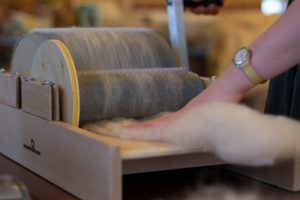Sheep are rapidly becoming one of my favourite animals.
They are such loveable balls of fluff and have so much to give back: meat (we just butchered our 8 month old ram lamb), milk (not yet, but we’re hoping that someday we’ll get to milk one of the ewes) and wool.
The wool is where we have been putting quite a bit of time lately. Here’s how it goes…
First the sheep need to be shorn.
Not wanting to invest immediately in expensive shearing equipment, we opted for a cheaper method: kitchen scissors! Then the wool needs washing. (Sorry, we don’t have any pictures of this step.) We give the fleeces three washes in hot soapy water to remove the lanolin (sheep grease). It is important to do this without agitation. Agitating wool when it is hot causes it to felt, rendering it useless. And then we rinse it, also in hot water.
Then the wool needs washing. (Sorry, we don’t have any pictures of this step.) We give the fleeces three washes in hot soapy water to remove the lanolin (sheep grease). It is important to do this without agitation. Agitating wool when it is hot causes it to felt, rendering it useless. And then we rinse it, also in hot water.
After washing it goes on racks to dry, or in our case, on frost fencing elevated off the ground by 2×4’s.
Once dry, the wool is skirted, which simply means that we remove any worthless bits of fiber, i.e. parts that have manure on them or sections that contain too much vegetable matter (hay).
At this point, the wool is ready for combing or carding. We didn’t have any carding equipment, so we did our first fleece with hair combs – a very time-consuming project as it meant combing one end of a lock, flipping it around and combing the other end!
Now we have a drum carder which speeds the process up enormously! The wool is put through the carder a bit a time for the first pass.
To line the fibers up better and to remove more vegetable matter, we send the wool through the carder about three times on average.
When the bat is removed for the final time, it is torn into long strips and moved on to the spinning wheel.

 Alternately, it can be removed from the drum in one long strip using a disk with a tiny hole in it. Our sheep’s short staple length makes this impracticable this year, but perhaps it will work with the longer wool we hope to get next year.
Alternately, it can be removed from the drum in one long strip using a disk with a tiny hole in it. Our sheep’s short staple length makes this impracticable this year, but perhaps it will work with the longer wool we hope to get next year.

At the spinning wheel, the rovings (long strips of wool) are drafted (drawn out into even thinner strands) and twisted before getting wound onto the bobbin.





 Once two bobbins are filled, the strands are plied together by being sent through the spinning wheel again, with the wheel spinning backwards this time.
Once two bobbins are filled, the strands are plied together by being sent through the spinning wheel again, with the wheel spinning backwards this time.
The wool is now ready to be used and turned into warm articles of clothing!














